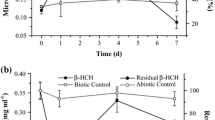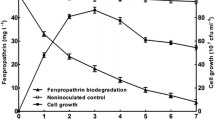Abstract
A newly isolated actinomycete strain HP-S-01 from activated sludge could effectively degrade deltamethrin and its major hydrolysis product 3-phenoxybenzaldehyde. Based on the morphological, cultural, physio-biochemical characteristics, and 16S rDNA sequence analysis, strain HP-S-01 was identified as Streptomyces aureus. Strain HP-S-01 was also found highly efficient in degrading cyfluthrin, bifenthrin, fenvalerate, fenpropathrin, permethrin, and cypermethrin. Strain HP-S-01 rapidly degraded deltamethrin without a lag phase over a wide range of temperature (18~38°C) and pH (5~10), and metabolized to produce α-hydroxy-3-phenoxy-benzeneacetonitrile and 3-phenoxybenzaldehyde by hydrolysis of the carboxylester linkage. The 3-phenoxybenzaldehyde was further oxidized to form 2-hydroxy-4-methoxy benzophenone resulting in its detoxification. No persistent accumulative product was detected by gas chromatography-mass spectrometry (GC/MS) analysis. Response surface methodology was used to optimize degradation conditions. Strain HP-S-01 completely removed 50~300 mg L−1 deltamethrin within 7 days under the optimal degradation conditions. Furthermore, the biodegradation kinetics corresponded with the first-order model. Therefore, strain HP-S-01 is suitable for the efficient and rapid bioremediation of pyrethroid-contaminated environment.









Similar content being viewed by others
References
Abdallah FB, Hamden K, Galeraud-Denis I, Feki AE, Keskes-Ammar L (2009) An in vitro study on reproductive toxicology of deltamethrin on rat spermatozoa. Andrologia 42:254–259
Aksakal E, Ceyhun SB, Erdoğan O, Ekinci D (2010) Acute and long-term genotoxicity of deltamethrin to insulin-like growth factors and growth hormone in rainbow trout. Comp Biochem Phys C 152:451–455
Anwar S, Liaquat F, Khan QM, Khalid ZM, Iqbal S (2009) Biodegradation of chlorpyrifos and its hydrolysis product 3, 5, 6-trichloro-2-pyridinolby Bacillus pumilus strain C2A1. J Hazard Mater 168:400–405
Balasubrarnanian V, Lakshminarayanan AK, Varahamoorthy R, Babu S (2009) Application of response surface methodolody to prediction of dilution in plasma transferred arc hardfacing of stainless steel on carbon steel. J Iron Steel Res Int 16(1):44–53
Bensultana A, Ouhdouch Y, Hassani L, Mezrioui NE, Rafouk L (2010) Isolation and characterization of wastewater sand filter actinomycetes. World J Microbiol Biotechnol 26:481–487
Brajesh K, Walker A (2006) Microbial degradation of organophosphorous compounds. FEMS Microbiol Rev 30:428–471
Chang BV, Chiang F, Yuan SY (2005) Biodegradation of nonylphenol in sewage sludge. Chemosphere 6:1652–1659
Cycoń M, Wojcik M, Piotrowska-Seget Z (2009) Biodegradation of the organophosphorus insecticide diazinon by Serratia sp. and Pseudomonas sp. and their use in bioremediation of contaminated soil. Chemosphere 76:494–501
Elliott M (1995) Chemicals in insect control. In: Casida JE, Quistad GB (eds) Pyrethrum flowers: production, chemistry, toxicology, and uses. Oxford University Press, NY
Ermakova IT, Kiseleva NI, Shushkova T, Zharikov M, Zharikov GA, Leontievsky AA (2010) Bioremediation of glyphosate-contaminated soils. Appl Microbiol Biotechnol 88:585–594
Fulekar MH (2009) Bioremediation of fenvalerate by Pseudomonas aeruginosa in a scale up bioreactor. Rom Biotechnol Lett 14:4900–4905
Grant RJ, Daniell TJ, Betts WB (2002) Isolation and identification of synthetic pyrethroid-degrading bacteria. J Appl Microbiol 92:534–540
Gu XZ, Zhang GY, Chen L, Dai RL, Yu YC (2008) Persistence and dissipation of synthetic pyrethroid pesticides in red soils from the Yangtze River Delta area. Environ Geochem Health 30:67–77
Guo P, Wang BZ, Hang BJ, Li L, Ali SW, He J, Li SP (2009) Pyrethroid-degrading Sphingobium sp. JZ-2 and the purification and characterization of a novel pyrethroid hydrolase. Int Biodeterior Biodegrad 63:1107–1112
Halden RU, Tepp SM, Halden BG, Dwyer DF (1999) Degradation of 3-phenoxybenzoic acid in soil by Pseudomonas pseudoalcaligenes POB310 (pPOB) and two modified Pseudomonas strains. Appl Environ Microbiol 65:3354–3359
Hamdali H, Hafidi M, Virolle MV, Ouhdouch Y (2008) Rock phosphate solubilizing actinomycetes: screening for plant growth-promoting activities. World J Microbiol Biotechnol 24:2565–2575
Hasegawa T, Takizawa M, Tanida S (1983) A rapid analysis for chemical grouping of aerobic actinomyces. J Gen Appl Microbiol 29:319–322
Heidari R, Devonshire AL, Campbell BE, Dorrian SJ, Oakeshott JG, Russell RJ (2005) Hydrolysis of pyrethroids by carboxylesterases from Lucilia cuprina and Drosophila melanogaster with active sites modified by in vitro mutagenesis. Insect Biochem Mol Biol 35:597–609
Holt JG, Krieg NR, Sneath PH, Staley JT, Williams ST (1994) Bergey’s manual of determinative bacteriology, 9th edn. Willian and Wilkins, Baltimore, MD
Hosseini-Parvar SH, Keramat J, Kadivar M, Khanipour E, Motamedzadegan A (2009) Optimising conditions for enzymatic extraction of edible gelatin from the cattle bones using response surface methodology. Int J Food Sci Technol 44:467–475
Katsuda Y (1999) Development of and future prospects for pyrethroid chemistry. Pestic Sci 55(8):775–782
Khan SU, Bekhi RM, Tapping RI, Akhbar MH (1988) Deltamethrin residues in an organic soil under laboratory conditions and its degradation by bacterial strain. J Agric Food Chem 36:636–638
Laffin B, Chavez M, Pine M (2010) The pyrethroid metabolites 3-phenoxybenzoic acid and 3-phenoxybenzyl alcohol do not exhibit estrogenic activity in the MCF-7 human breast carcinoma cell line or Sprague-Dawley rats. Toxicology 267:39–44
Liu PY, Liu YJ, Liu QX, Liu JW (2010) Photodegradation mechanism of deltamethrin and fenvalerate. J Environ Sci 22(7):1123–1128
McKinlay R, Plant JA, Bell JN, Voulvoulis N (2008) Endocrine disrupting pesticides: implications for risk assessment. Environ Int 34:168–183
Paingankar M, Jain M, Deobagkar D (2005) Biodegradation of allethrin, a pyrethroid insecticide by an Acidomonas sp. Biotechnol Lett 27:1909–1913
Perry MJ, Venners SA, Barr DB, Xu XP (2007) Environmental pyrethroid and organophosphorus insecticide exposures and sperm concentration. Reprod Toxicol 23:113–118
Saikia N, Das SK, Patel BKC, Niwas R, Singh A, Gopal M (2005) Biodegradation of beta-cyfluthrin by Pseudomonas stutzeri strain S1. Biodegradation 16:581–589
Sambrook J, Russell DW (2001) Molecular cloning: a laboratory manual, 3rd edn. Cold Spring Harbor Laboratory, NY
Shafer TJ, Meyer DA, Crofton KM (2005) Developmental neurotoxicity of pyrethroid insecticides: critical review and future research needs. Environ Health Perspect 113(2):123–136
Shukla Y, Yadav A, Arora A (2002) Carcinogenic and cocarcinogenic potential of cypermethrin on mouse skin. Cancer Lett 182:33–41
Singh BK, Walker A, Morgan JA, Wright DJ (2003) Effects of soil pH on the biodegradation of chlorpyrifos and isolation of a chlorpyrifos-degrading bacterium. Appl Environ Microbiol 69:5198–5206
Singh BK, Walker A, Morgan JA, Wright DJ (2004) Biodegradation of chlorpyrifos by Enterobacter strain B-14 and its use in bioremediation of contaminated soils. Appl Environ Microbiol 70:4855–4863
Sun H, Xu XL, Xu LC, Song L, Hong X, Chen JF, Cui LB, Wang XR (2006) Antiandrogenic activity of pyrethroid pesticides and their metabolite in reporter gene assay. Chemosphere 66:474–479
Tallur PN, Megadi VB, Ninnekar HZ (2008) Biodegradation of cypermethrin by Micrococcus sp. strain CPN 1. Biodegradation 28:77–82
Tamura K, Dudley J, Nei M (2007) MEGA4: molecular evolutionary genetics analysis (MEGA) software version 4.0. Mol Biol Evol 24:1596–1599
Topp E, Akhtar MH (1991) Identification and characterization of a pseudomonas strain capable of metabolizing phenoxybenzoates. Appl Environ Microbiol 57:1294–1300
Tyler CR, Beresford N, van der Woning M, Sumpter JP, Thorpe K (2000) Metabolism and environmental degradation of pyrethroid insecticides produce compounds with endocrine activities. Environ Toxicol Chem 19:801–809
Ueda JY, Hashimoto J, Yamamura H, Hayakawa M, Takagi M, Kazuo SY (2010) A new 16-membered tetraene macrolide JBIR-100 from a newly identified Streptomyces species. J Antibiot 63:627–629
Waksman SA (1959) The actinomycetes, vol I: nature, occurrence and activities. Williams and Wilkins, Baltimore, MD
Wang BZ, Guo P, Hang BJ, Li L, He J, Li SP (2009a) Cloning of a novel pyrethroid-hadrolyzing carboxylesterase gene from Sphingobium sp. strain JZ-1 and characteization of the gene product. Appl Environ Microbiol 75:5496–5500
Wang C, Chen F, Zhang Q, Fang Z (2009b) Chronic toxicity and cytotoxicity of synthetic pyrethroid insecticide cis-bifenthrin. J Environ Sci 21:1710–1715
Wolansky MJ, Harrill JA (2008) Neurobehavioral toxicology of pyrethroid insecticides in adult animals: a critical review. Neurotoxicol Teratol 30:55–78
Xia WJ, Zhou JM, Wang HY, Chen XQ (2008) Effect of nitrogen on the degradation of cypermethrin and its metabolite 3-phenoxybenzoic acid in soil. Pedosphere 18:638–644
Xu YX, Li XH, Qin H, Li SP (2005) Isolation and characteristics of a 3-phenoxybenzoic acid degrading-bacterium. J Microbiol 32:62–66
Xu YX, Sun JQ, Li XH, Li SP, Chen Y (2007) Study on cooperating degradation of cypermethrin and 3-phenoxybenzoic acid by two bacteria strains. Acta Microbiol Sin 47:834–837
Xu GM, Zheng W, Li YY, Wang SH, Zhang JS, Yan YC (2008) Biodegradation of chlorpyrifos and 3,5,6-trichloro-2-pyridinol by a newly ioslated Paracoccus sp. TRP. Int Biodeterior Biodegrad 62:51–56
Yuan C, Wang C, Gao SQ, Kong TT, Chen L, XF L, Song L, Wang YB (2010) Effects of permethrin, cypermethrin and 3-phenoxybenzoic acid on rat sperm motility in vitro evaluated with computer-assisted sperm analysis. Toxicol Vitro 24:382–386
Zhang ZY, Liu XJ, Yu XY, Zhang CZ, Hong XY (2007) Pesticide residues in the spring cabbage. (Brassica oleracea L. var. capitata) grown in open field. Food Control 18:723–730
Zhang C, Jia L, Wang SH, Qu J, Xu LL, Shi HH, Yan YC (2010) Biodegradation of beta-cypermethrin by two Serratia spp. with different cell surface hydrophobicity. Bioresour Technol 101:3423–3429
Zhao MR, Zhang Y, Liu WP, Xu C, Wang LM, Gan JY (2008) Estrogenic activity of lambda-cyhalothrin in the MCF-7 human breast carcinoma cell line. Environ Toxicol Chem 27(5):1194–1200
Acknowledgments
The authors gratefully acknowledge the grants from the National Natural Science Foundation (No.30871660) and Project of Scientific Technological Planning of Guangdong Province (No.2009B020310005), P.R. China.
Author information
Authors and Affiliations
Corresponding author
Rights and permissions
About this article
Cite this article
Chen, S., Lai, K., Li, Y. et al. Biodegradation of deltamethrin and its hydrolysis product 3-phenoxybenzaldehyde by a newly isolated Streptomyces aureus strain HP-S-01. Appl Microbiol Biotechnol 90, 1471–1483 (2011). https://doi.org/10.1007/s00253-011-3136-3
Received:
Revised:
Accepted:
Published:
Issue Date:
DOI: https://doi.org/10.1007/s00253-011-3136-3




